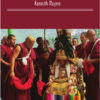In the 1970s it was commonly asserted that “Chinese religion,” at least as it had existed during Qing dynasty times, had ceased to existed together. But something rather curious occurred between the 1970s to the late 1990s and the present. Chinos home to more than 20 million Muslims, and the number of mosques, including women only mosques, has been rapidly growing. Chinos also predicted to become the world’s largest Christian nation with in ten years. Tibetan Buddhism, once amino religion, now a days attracts a large number of followers among the wealthy and educated Chinese middle class. Periodically there is another crack down on religious activity, but it would certainly appear that religion in China today, which is clearly derivative of traditional Chinese religion, with certain modern additions, has come back within creasing force. For the most part, nowadays the Chinese people have relative autonomy to practice any of the officially approved religions, as long as that does not pose a challenge to the established social order or the political status quo. An increasing number of people are availing themselves to the varied opportunities for religious engagement and expression. On the whole, there is a discernible trend towards greater religious participation, although China still comes across as being much more secular when compared to other countries with high levels of religious belief and affiliation, such as the US or India. On the other hand, there is probably more religious participation in China than in much of Europe.
Religion in Contemporary China: Revitalization and Innovation provides wide-ranging studies of contemporary religious practices in China. It examines the different processes and me charisms of religious revivals and innovations, and, more broadly, relates the Chinese example of religious revitalization to larger issues of social and cultural continuity and change. Along with China’s a astonishing economic grow thin recent years, Chinese religions have enjoyed remarkable renaissance. Buddhist, Daoist, and popular religious temples have flourished. It focuses on the fact or underlie nighen-going popularity of temple cults, local deities, temple festivals, and the privatization of popular beliefs—which are all deeplyrootedin Chinese rural life. In addition, it tries to offers omen new perspective son the study of urban religion in contemporary China.












